Best Picture
Winner: The Broadway Melody (1929) - M-G-M
Other Nominees:
- Alibi (1929) - Feature Productions
- In Old Arizona (1928) - Fox
- The Hollywood Revue of 1929 (1929) - M-G-M
- The Patriot (1928) - Paramount Famous Lasky
Best Actor in a Leading Role
Winner: In Old Arizona (1928) - Warner Baxter
Other Nominees:
- Alibi (1929) - Chester Morris
- The Patriot (1928) - Lewis Stone
- The Valiant (1929) - Paul Muni
- Thunderbolt (1929) - George Bancroft
Best Actress in a Leading Role
Winner: Coquette (1929) - Mary Pickford
Other Nominees:
- Madame X (1929) - Ruth Chatterton
- The Barker (1928) - Betty Compson
- The Broadway Melody (1929) - Bessie Love
- The Divine Lady (1929) - Corinne Griffith
- The Letter (1929) - Jeanne Eagels
Best Director
Winner: The Divine Lady (1929) - Frank Lloyd
Other Nominees:
- Drag (1929) - Frank Lloyd
- In Old Arizona (1928) - Irving Cummings
- Madame X (1929) - Lionel Barrymore
- The Broadway Melody (1929) - Harry Beaumont
- The Patriot (1928) - Ernst Lubitsch
- Weary River (1929) - Frank Lloyd
Best Writing, Achievement
Winner: The Patriot (1928) - Hanns Kräly
Other Nominees:
- A Woman of Affairs (1928) - Bess Meredyth
- In Old Arizona (1928) - Tom Barry
- Our Dancing Daughters (1928) - Josephine Lovett
- Sal of Singapore (1928) - Elliott J. Clawson
- Skyscraper (1928) - Elliott J. Clawson
- The Cop (1928) - Elliott J. Clawson
- The Last of Mrs. Cheyney (1929) - Hanns Kräly
- The Leatherneck (1929) - Elliott J. Clawson
- The Valiant (1929) - Tom Barry
- Wonder of Women (1929) - Bess Meredyth
Best Cinematography
Winner: White Shadows in the South Seas (1928) - Clyde De Vinna
Other Nominees:
- 4 Devils (1928) - Ernest Palmer
- In Old Arizona (1928) - Arthur Edeson
- Our Dancing Daughters (1928) - George Barnes
- Street Angel (1928) - Ernest Palmer
- The Divine Lady (1929) - John F. Seitz
Best Art Direction
Winner: The Bridge of San Luis Rey (1929) - Cedric Gibbons
Other Nominees:
- Alibi (1929) - William Cameron Menzies
- Dynamite (1929) - Mitchell Leisen
- Street Angel (1928) - Harry Oliver
- The Awakening (1928) - William Cameron Menzies
- The Patriot (1928) - Hans Dreier
Showing posts with label 2nd Academy Awards. Show all posts
Showing posts with label 2nd Academy Awards. Show all posts
Tuesday, July 14, 2009
Monday, July 13, 2009
The Lost Films: 2nd Academy Awards
In the days before television, VHS and DVD, not a lot of thought was given to film preservation. As such, the further you go back, the harder it is to find copies of certain films. There were a lot of films nominated during the 2nd Academy Awards that are either completely lost or unavailable in any consumable format.
Should any of these films become available, I promise to go back and review them.
---
4 Devils (1928)
Nominated For: Best Cinematography (Ernest Palmer)
According to Wikipedia:
"The plot concerns four orphans (Anders Randolf, Barry Norton, Charles Morton, and Gaynor) who become a high wire act, and centers around sinister goings-on at a circus."
The film is sadly lost. Details are available on the DVD of Sunrise: A Tale of Two Humans.
---
The Awakening (1928)
Nominated For: Best Art Direction (William Cameron Menzies)
Can't find much information on it, besides that it takes place in World War I. No known copy exists.
---
The Barker (1928)
Nominated For: Best Actress in a Leading Role (Betty Compson)
Plot according to Turner Classic Movies:
"Nifty Miller, the greatest carnival barker in the world, sends his son, Chris, to law school in the hope that the boy will find in professional life a more settled and prosperous life than that of the sideshow. During one of his summer vacations, Chris finds work with the carnival, and Nifty breaks off his relationship with Carrie, a hula dancer who, seeking revenge for this slight, pays another carnival girl, Lou, to vamp the innocent boy; Lou, however, genuinely falls in love with Chris. When his father finds out that they are in love, Chris defiantly announces his intention to marry the girl. Seeing his ambitious plans for his son seemingly collapse, Nifty quits the carnival and turns to drink. He later finds out that Chris has returned to law school at Lou's urging. Offered a partnership in the carnival, Nifty returns to his former life as a barker."
Prints exist, but no VHS or DVDs
---
The Bridge of San Luis Rey (1929)
Won: Best Art Direction (Cedric Gibbons)
Wikipedia on the novel the film was adapted from:
"It tells the story of several interrelated people who die in the collapse of an Inca rope-fiber suspension bridge in Peru, and the events that lead up to their being on the bridge. A friar who has witnessed the tragic accident then goes about inquiring into the lives of the victims, seeking some sort of cosmic answer to the question of why each had to die."
A part-talkie, part-silent film. The talkie portions are lost, and the remaining parts of the film are in storage and are unavailable.
---
The Cop (1928)
Nominated For: Best Writing, Achievement (Elliott J. Clawson)
Not much information on this film, a print might exist at the Library of Congress.
---
The Divine Lady (1929)
Won: Best Director (Frank Lloyd)
Nominated For: Best Actress in a Leading Role (Corinne Griffith)
Best Cinematography (John F. Seitz)
The plot according to IMDb:
"A partly fictionalized account of history begins with the arrival of slatternly Emma Hart, a cook's daughter, at the home of Charles Greville. Greville takes her as his lover and grooms her until their relationship becomes an inconvenience. Greville then dupes Emma into traveling to Naples to live with his uncle, Lord Hamilton, ambassador to the court at Naples. Realizing that Greville has abandoned her, Emma agrees to marry Lord Hamilton. Soon, however, she meets Admiral Horatio Nelson of the British Navy. Emma plays a crucial role in convincing Naples to open its ports to Nelson during his campaign against Napoleon's French fleet. Soon, Emma and the married Nelson become romantically involved -- a relationship which will have consequences for them both."
Prints exist, and it's aired on Turner Classic Movies a few times. Possible review in the future.
---
Drag (1929)
Nominated For: Best Director (Frank Lloyd)
Plot according to Turner Classic Movies:
"Young David Carroll takes over the publication of a local Vermont newspaper. Although he is attracted to Dot, "the most sophisticated girl in town," he marries Allie Parker, daughter of the couple who run the boardinghouse where he lives. Inseparable from her parents, Allie remains at home when David goes to New York City to sell a musical he has written. There, Dot, now a successful costume designer, uses her influence to get David's play produced. David and Dot fall in love, but she leaves for Paris when David indicates he will remain true to Allie. He sends for Allie; but when she arrives with her whole family, he decides to follow Dot to Paris."
Prints seem to exist, not much information beyond that.
---
Dynamite (1929)
Nominated For: Best Art Direction (Mitchell Leisen)
The plot, according to IMDb:
"Wealthy Cynthia is in love with not-so-wealthy Roger, who is married to Marcia. The threesome is terribly modern about the situation, and Marcia will gladly divorce Roger if Cynthia agrees to a financial settlement. But Cynthia's wealth is in jeopardy because her trust fund will expire if she is not married by a certain date. To satisfy that condition, Cynthia arranges to marry Hagon Derk, who is condemned to die for a crime he didn't commit. She pays him so he can provide for his little sister. But at the last minute, Derk is freed when the true criminal is discovered. Expecting to be a rich widow, Cynthia finds herself married to a man she doesn't know and doesn't want to."
The film is in rotation on Turner Classic Movies, but no VHS or DVD is available. A possible review coming in the future.
---
The Last of Mrs. Cheyney (1929)
Nominated For: Best Writing, Achievement (Hanns Kräly)
The plot according to IMDb:
"There is a big charity function at the house of Mrs. Cheyney and a lot of society is present. With her rich husband, deceased, rich old Lord Elton and playboy Lord Arthur Dilling are both very interested in the mysterious Fay. Invited to the house of Mrs. Webley, Fay is again the center of attention for Arthur and Elton with her leaning towards stuffy old Elton. When Arthur sees Charles, Fay's Butler, lurking in the gardens, he remembers that Charles was a thief caught in Monte Carlo and he figures that Fay may be more interested in the pearls of Mrs. Webley, which she is. After Fay takes the pearls, but before she can toss them out the window, she is caught by Arthur who is very disappointed in how things are turning out."
Prints seem to be available, but no VHS or DVD copies.
---
The Leatherneck (1929)
Nominated For: Best Writing, Achievement (Elliott J. Clawson)
Can't find much information. If prints are available, there isn't any VHS or DVD copies.
---
Madame X (1929)
Nominated For: Best Actress in a Leading Role (Ruth Chatterton)
Best Director (Lionel Barrymore)
Plot according to IMDb:
"Thrown out of her home by a jealous husband, a woman sinks into degradation. Twenty years later, she is charged with killing a man bent on harming her son. The son, unaware of who the woman is, takes the assignment to defend her in court."
Prints exist, will probably review in the future.
---
The Patriot (1928)
Won: Best Writing, Achievement (Hanns Kräly)
Nominated For: Best Actor in a Leading Role (Lewis Stone)
Best Art Direction (Hans Dreier)
Best Director (Wrnst Lubitsch)
Best Picture
The tag line according to IMDb:
"These Characters Will Fascinate You! EMIL JANNINGS - Cruel, brutal, but also pathetic. The mad Czar who holds all Russia in his tyrannical grasp. FLORENCE VIDOR - An exotic beauty of the court. The Czar's favorite! Betrayed by her lover, she becomes a thorn in the hands of the conspirators! LEWIS STONE - Prime Minister and trusted friend of the mad Czar, who conspires against the monster ruler of Russia. NEIL HAMILTON - Heir to the throne. Worshipped by the Russians. The only man who can hold the government from self-destruction."
This film is very, very lost. Chances of finding it are 0 to nil. It is the only Best Picture nominee for which no complete or near-complete copy exists.
---
Sal of Singapore (1928)
Nominated For: Best Writing, Achievement (Elliott J. Clawson)
Not much information. A print supposedly exists at UCLA.
---
Skyscraper (1928)
Nominated For: Best Writing, Achievement (Elliott J. Clawson)
The plot according to Turner Classic Movies:
"Blondy and Slim, buddies, are high steel workers. Blondy falls and is seriously injured while attempting to rescue Slim. As a result of his injury he can no longer work, and he falls into a reclusive depression. Only after his friend pretends to be interested in his sweetheart does he recover his spirit and become well again."
Not much information on availablity.
---
Thunderbolt (1929)
Nominated For: Best Actor in a Leading Role (George Bancroft)
Plot according to IMDb:
"A criminal known as Thunderbolt is imprisoned and facing execution. Into the next cell is placed Bob Morgan, an innocent man who has been framed and who is in love with Thunderbolt's girl, without knowing of their relationship. Thunderbolt hopes to stave off the execution long enough to kill young Morgan for romancing his girl."
Not much information on availability.
---
The Valiant (1929)
Nominated For: Best Actor in a Leading Role (Paul Muni)
Best Writing, Achievement (Tom Barry)
The plot according to Wikipedia:
"The play's plot is actually quite convoluted. The basic story of the plot is that a half an hour before a murderer's execution, the Warden and the Prison Chaplain attempt to discern the prisoner's identity. He meets his long lost sister, although the end is slightly ambiguous if one is not paying attention. The play ends with the exit of the murderer, the Chaplain and the Warden."
Prints exist only in private collections.
---
Weary River (1929)
Nominated For: Best Director (Frank Lloyd)
Plot according to Turner Classic Movies:
"Bootlegger Jerry Larrabee is framed by a rival gangster and is sent to prison, where he comes under the kindly influence of the warden. Jerry turns to music and forms a prison band, broadcasting over the radio. Radio listeners are deeply moved by his singing, and Jerry wins an early parole. He goes into vaudeville and quickly flops; he then moves from job to job, haunted by the past. Forced at last to return to his old gang, Jerry takes up with his former sweetheart, Alice. She gets in touch with the warden, who arrives on the scene in time to keep Jerry on the straight and narrow path. Jerry eventually becomes a radio star and marries Alice."
Prints exist, may review in the future.
---
Wonder of Women (1929)
Nominated For: Best Writing, Achievement (Bess Meredyth)
The really short synopsis from IMDb:
"A German pianist is going to break up with his unfaithful wife, when he receives the message that his favourite stepchild has died."
Despite a rumor of a laserdisc existing at UCLA, this film is pretty lost.
Should any of these films become available, I promise to go back and review them.
---
4 Devils (1928)
Nominated For: Best Cinematography (Ernest Palmer)
According to Wikipedia:
"The plot concerns four orphans (Anders Randolf, Barry Norton, Charles Morton, and Gaynor) who become a high wire act, and centers around sinister goings-on at a circus."
The film is sadly lost. Details are available on the DVD of Sunrise: A Tale of Two Humans.
---
The Awakening (1928)
Nominated For: Best Art Direction (William Cameron Menzies)
Can't find much information on it, besides that it takes place in World War I. No known copy exists.
---
The Barker (1928)
Nominated For: Best Actress in a Leading Role (Betty Compson)
Plot according to Turner Classic Movies:
"Nifty Miller, the greatest carnival barker in the world, sends his son, Chris, to law school in the hope that the boy will find in professional life a more settled and prosperous life than that of the sideshow. During one of his summer vacations, Chris finds work with the carnival, and Nifty breaks off his relationship with Carrie, a hula dancer who, seeking revenge for this slight, pays another carnival girl, Lou, to vamp the innocent boy; Lou, however, genuinely falls in love with Chris. When his father finds out that they are in love, Chris defiantly announces his intention to marry the girl. Seeing his ambitious plans for his son seemingly collapse, Nifty quits the carnival and turns to drink. He later finds out that Chris has returned to law school at Lou's urging. Offered a partnership in the carnival, Nifty returns to his former life as a barker."
Prints exist, but no VHS or DVDs
---
The Bridge of San Luis Rey (1929)
Won: Best Art Direction (Cedric Gibbons)
Wikipedia on the novel the film was adapted from:
"It tells the story of several interrelated people who die in the collapse of an Inca rope-fiber suspension bridge in Peru, and the events that lead up to their being on the bridge. A friar who has witnessed the tragic accident then goes about inquiring into the lives of the victims, seeking some sort of cosmic answer to the question of why each had to die."
A part-talkie, part-silent film. The talkie portions are lost, and the remaining parts of the film are in storage and are unavailable.
---
The Cop (1928)
Nominated For: Best Writing, Achievement (Elliott J. Clawson)
Not much information on this film, a print might exist at the Library of Congress.
---
The Divine Lady (1929)
Won: Best Director (Frank Lloyd)
Nominated For: Best Actress in a Leading Role (Corinne Griffith)
Best Cinematography (John F. Seitz)
The plot according to IMDb:
"A partly fictionalized account of history begins with the arrival of slatternly Emma Hart, a cook's daughter, at the home of Charles Greville. Greville takes her as his lover and grooms her until their relationship becomes an inconvenience. Greville then dupes Emma into traveling to Naples to live with his uncle, Lord Hamilton, ambassador to the court at Naples. Realizing that Greville has abandoned her, Emma agrees to marry Lord Hamilton. Soon, however, she meets Admiral Horatio Nelson of the British Navy. Emma plays a crucial role in convincing Naples to open its ports to Nelson during his campaign against Napoleon's French fleet. Soon, Emma and the married Nelson become romantically involved -- a relationship which will have consequences for them both."
Prints exist, and it's aired on Turner Classic Movies a few times. Possible review in the future.
---
Drag (1929)
Nominated For: Best Director (Frank Lloyd)
Plot according to Turner Classic Movies:
"Young David Carroll takes over the publication of a local Vermont newspaper. Although he is attracted to Dot, "the most sophisticated girl in town," he marries Allie Parker, daughter of the couple who run the boardinghouse where he lives. Inseparable from her parents, Allie remains at home when David goes to New York City to sell a musical he has written. There, Dot, now a successful costume designer, uses her influence to get David's play produced. David and Dot fall in love, but she leaves for Paris when David indicates he will remain true to Allie. He sends for Allie; but when she arrives with her whole family, he decides to follow Dot to Paris."
Prints seem to exist, not much information beyond that.
---
Dynamite (1929)
Nominated For: Best Art Direction (Mitchell Leisen)
The plot, according to IMDb:
"Wealthy Cynthia is in love with not-so-wealthy Roger, who is married to Marcia. The threesome is terribly modern about the situation, and Marcia will gladly divorce Roger if Cynthia agrees to a financial settlement. But Cynthia's wealth is in jeopardy because her trust fund will expire if she is not married by a certain date. To satisfy that condition, Cynthia arranges to marry Hagon Derk, who is condemned to die for a crime he didn't commit. She pays him so he can provide for his little sister. But at the last minute, Derk is freed when the true criminal is discovered. Expecting to be a rich widow, Cynthia finds herself married to a man she doesn't know and doesn't want to."
The film is in rotation on Turner Classic Movies, but no VHS or DVD is available. A possible review coming in the future.
---
The Last of Mrs. Cheyney (1929)
Nominated For: Best Writing, Achievement (Hanns Kräly)
The plot according to IMDb:
"There is a big charity function at the house of Mrs. Cheyney and a lot of society is present. With her rich husband, deceased, rich old Lord Elton and playboy Lord Arthur Dilling are both very interested in the mysterious Fay. Invited to the house of Mrs. Webley, Fay is again the center of attention for Arthur and Elton with her leaning towards stuffy old Elton. When Arthur sees Charles, Fay's Butler, lurking in the gardens, he remembers that Charles was a thief caught in Monte Carlo and he figures that Fay may be more interested in the pearls of Mrs. Webley, which she is. After Fay takes the pearls, but before she can toss them out the window, she is caught by Arthur who is very disappointed in how things are turning out."
Prints seem to be available, but no VHS or DVD copies.
---
The Leatherneck (1929)
Nominated For: Best Writing, Achievement (Elliott J. Clawson)
Can't find much information. If prints are available, there isn't any VHS or DVD copies.
---
Madame X (1929)
Nominated For: Best Actress in a Leading Role (Ruth Chatterton)
Best Director (Lionel Barrymore)
Plot according to IMDb:
"Thrown out of her home by a jealous husband, a woman sinks into degradation. Twenty years later, she is charged with killing a man bent on harming her son. The son, unaware of who the woman is, takes the assignment to defend her in court."
Prints exist, will probably review in the future.
---
The Patriot (1928)
Won: Best Writing, Achievement (Hanns Kräly)
Nominated For: Best Actor in a Leading Role (Lewis Stone)
Best Art Direction (Hans Dreier)
Best Director (Wrnst Lubitsch)
Best Picture
The tag line according to IMDb:
"These Characters Will Fascinate You! EMIL JANNINGS - Cruel, brutal, but also pathetic. The mad Czar who holds all Russia in his tyrannical grasp. FLORENCE VIDOR - An exotic beauty of the court. The Czar's favorite! Betrayed by her lover, she becomes a thorn in the hands of the conspirators! LEWIS STONE - Prime Minister and trusted friend of the mad Czar, who conspires against the monster ruler of Russia. NEIL HAMILTON - Heir to the throne. Worshipped by the Russians. The only man who can hold the government from self-destruction."
This film is very, very lost. Chances of finding it are 0 to nil. It is the only Best Picture nominee for which no complete or near-complete copy exists.
---
Sal of Singapore (1928)
Nominated For: Best Writing, Achievement (Elliott J. Clawson)
Not much information. A print supposedly exists at UCLA.
---
Skyscraper (1928)
Nominated For: Best Writing, Achievement (Elliott J. Clawson)
The plot according to Turner Classic Movies:
"Blondy and Slim, buddies, are high steel workers. Blondy falls and is seriously injured while attempting to rescue Slim. As a result of his injury he can no longer work, and he falls into a reclusive depression. Only after his friend pretends to be interested in his sweetheart does he recover his spirit and become well again."
Not much information on availablity.
---
Thunderbolt (1929)
Nominated For: Best Actor in a Leading Role (George Bancroft)
Plot according to IMDb:
"A criminal known as Thunderbolt is imprisoned and facing execution. Into the next cell is placed Bob Morgan, an innocent man who has been framed and who is in love with Thunderbolt's girl, without knowing of their relationship. Thunderbolt hopes to stave off the execution long enough to kill young Morgan for romancing his girl."
Not much information on availability.
---
The Valiant (1929)
Nominated For: Best Actor in a Leading Role (Paul Muni)
Best Writing, Achievement (Tom Barry)
The plot according to Wikipedia:
"The play's plot is actually quite convoluted. The basic story of the plot is that a half an hour before a murderer's execution, the Warden and the Prison Chaplain attempt to discern the prisoner's identity. He meets his long lost sister, although the end is slightly ambiguous if one is not paying attention. The play ends with the exit of the murderer, the Chaplain and the Warden."
Prints exist only in private collections.
---
Weary River (1929)
Nominated For: Best Director (Frank Lloyd)
Plot according to Turner Classic Movies:
"Bootlegger Jerry Larrabee is framed by a rival gangster and is sent to prison, where he comes under the kindly influence of the warden. Jerry turns to music and forms a prison band, broadcasting over the radio. Radio listeners are deeply moved by his singing, and Jerry wins an early parole. He goes into vaudeville and quickly flops; he then moves from job to job, haunted by the past. Forced at last to return to his old gang, Jerry takes up with his former sweetheart, Alice. She gets in touch with the warden, who arrives on the scene in time to keep Jerry on the straight and narrow path. Jerry eventually becomes a radio star and marries Alice."
Prints exist, may review in the future.
---
Wonder of Women (1929)
Nominated For: Best Writing, Achievement (Bess Meredyth)
The really short synopsis from IMDb:
"A German pianist is going to break up with his unfaithful wife, when he receives the message that his favourite stepchild has died."
Despite a rumor of a laserdisc existing at UCLA, this film is pretty lost.
Hollywood and The Broadway Melody
The Broadway Melody (1929)
DIRECTED BY: Harry Beaumont
STARRING: Anita Page, Bessie Love, Charles King
WON: Best Picture
NOMINATED FOR: Best Actress in a Leading Role (Bessie Love)
Best Director (Harry Beaumont)
The 2nd Best Picture winner opens big, with a vast shot of New York City as filmed from an airplane.

We spend about half a minute to absorb the setting. Similar shots were used in The Crowd to reveal the city as a massive machine, impossible for any individual to conquer, where as Speedy took the same kind of shots to create a poem celebrating the city for it's communities and quirks.
The Broadway Melody shares neither of those ambitions. The film mearly shows New York for the sake of showing New York, and then confines the rest of the film into tiny sound stages. That sums up the film perfectly: A film that by every right should have been ambitious and interesting, but decided to confine itself in trite and confusing plot points.
The film holds the distinction of being one of the first musicals ever, and the first musical to win Best Picture. That doesn't mean anything, though. The songs are just songs. They are not used to tell the story, they aren't related to the actual plot, the film is put on hold so that the actors can sing them. I'm not even sure if you could call that a musical.
And is it really that smart to make a musical this early into the history of talkies? People could barely figure out microphones, let alone sound editing, and scenes involving more then one person talking or making noise turned the scenes into clustered messes. Here's a scene near the beginning that's the perfect example of what I'm talking about, which also follows into the film's first song:
Hope you like that song, because it's not the last time we hear it.

Beyond bad sound and quaint songs, the film doesn't offer anything beyond a by-the-numbers struggle-for-success story, only now in sound for the first time. Two small town girls, Hank and Queenie Mahoney, make a new home in a New York hotel, trying to break into Broadway. They have a friend named Eddie on the inside, the big wig star you saw singing earlier, who is also Hank's boyfriend. They haven't seen Eddie for a while, so when Eddie sees how much Queenie has blossomed...
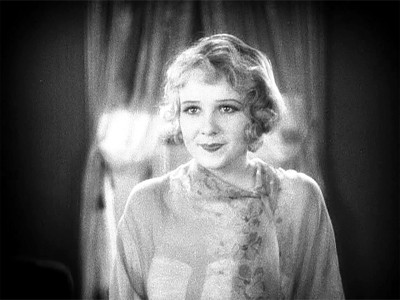
...he IMMEDIATELY jumps ship.
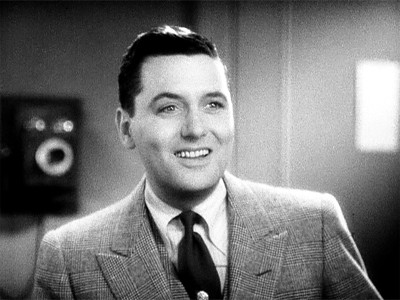
Queenie isn't the smartest apple, and Eddie is shallow as all hell, but you're not going to believe this, but these two are the characters we're supposed to attach ourselves to. By the end of the film, Eddie will have cheated on Hank, Queenie will have turned down the advances of a rich but really really nice producer (who everybody in the film hates for no reason I can see), and then the two get married and we're supposed to treat this like a happy ending. I'm not sure if this is just an example of old-school 1920s values or some clunky attempt at a sad ending.
What the hell is this movie supposed to be?
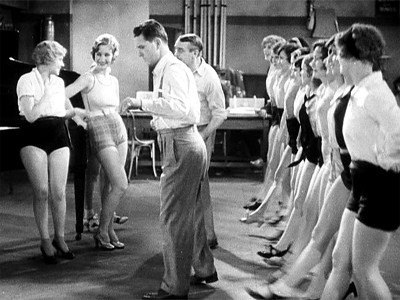
If I was to say anything nice about this film, it'd probably be that it provides a decent look at the behind-the-scenes of the Broadway variety shows of the time, and boy, do they seem like totally unappealing places. Nobody gets along, both the performers and producers are there just to make money... well, I guess that's pretty accurate t0 any job.
The Broadway performances themselves are standard fare and unimaginative, but even if they were amazing, we could barely see them anyway.
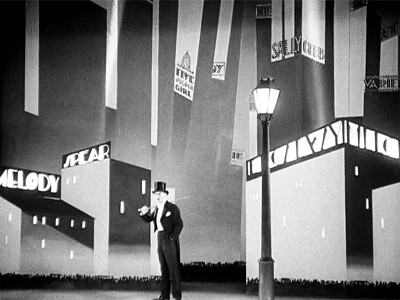
I suppose the filmmakers wanted to give us the feeling of being at an actual Broadway show, sitting in a decent middle row seat. This was an unfortunate attitude, and it makes the performances little and insignificant.
There's nothing really beyond this. Once again, I find myself with fewer things to say about the Best Picture winner then I do with the other nominees. The Broadway Melody isn't an awful film, it's just uninteresting and uninventive in a time where films really needed both.
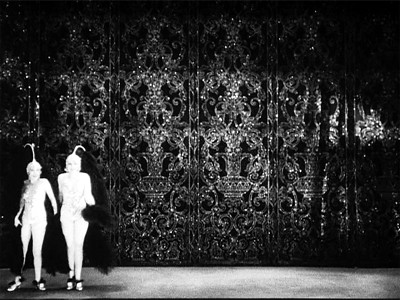
DIRECTED BY: Harry Beaumont
STARRING: Anita Page, Bessie Love, Charles King
WON: Best Picture
NOMINATED FOR: Best Actress in a Leading Role (Bessie Love)
Best Director (Harry Beaumont)
The 2nd Best Picture winner opens big, with a vast shot of New York City as filmed from an airplane.

We spend about half a minute to absorb the setting. Similar shots were used in The Crowd to reveal the city as a massive machine, impossible for any individual to conquer, where as Speedy took the same kind of shots to create a poem celebrating the city for it's communities and quirks.
The Broadway Melody shares neither of those ambitions. The film mearly shows New York for the sake of showing New York, and then confines the rest of the film into tiny sound stages. That sums up the film perfectly: A film that by every right should have been ambitious and interesting, but decided to confine itself in trite and confusing plot points.
The film holds the distinction of being one of the first musicals ever, and the first musical to win Best Picture. That doesn't mean anything, though. The songs are just songs. They are not used to tell the story, they aren't related to the actual plot, the film is put on hold so that the actors can sing them. I'm not even sure if you could call that a musical.
And is it really that smart to make a musical this early into the history of talkies? People could barely figure out microphones, let alone sound editing, and scenes involving more then one person talking or making noise turned the scenes into clustered messes. Here's a scene near the beginning that's the perfect example of what I'm talking about, which also follows into the film's first song:
Hope you like that song, because it's not the last time we hear it.

Beyond bad sound and quaint songs, the film doesn't offer anything beyond a by-the-numbers struggle-for-success story, only now in sound for the first time. Two small town girls, Hank and Queenie Mahoney, make a new home in a New York hotel, trying to break into Broadway. They have a friend named Eddie on the inside, the big wig star you saw singing earlier, who is also Hank's boyfriend. They haven't seen Eddie for a while, so when Eddie sees how much Queenie has blossomed...

...he IMMEDIATELY jumps ship.

Queenie isn't the smartest apple, and Eddie is shallow as all hell, but you're not going to believe this, but these two are the characters we're supposed to attach ourselves to. By the end of the film, Eddie will have cheated on Hank, Queenie will have turned down the advances of a rich but really really nice producer (who everybody in the film hates for no reason I can see), and then the two get married and we're supposed to treat this like a happy ending. I'm not sure if this is just an example of old-school 1920s values or some clunky attempt at a sad ending.
What the hell is this movie supposed to be?

If I was to say anything nice about this film, it'd probably be that it provides a decent look at the behind-the-scenes of the Broadway variety shows of the time, and boy, do they seem like totally unappealing places. Nobody gets along, both the performers and producers are there just to make money... well, I guess that's pretty accurate t0 any job.
The Broadway performances themselves are standard fare and unimaginative, but even if they were amazing, we could barely see them anyway.

I suppose the filmmakers wanted to give us the feeling of being at an actual Broadway show, sitting in a decent middle row seat. This was an unfortunate attitude, and it makes the performances little and insignificant.
There's nothing really beyond this. Once again, I find myself with fewer things to say about the Best Picture winner then I do with the other nominees. The Broadway Melody isn't an awful film, it's just uninteresting and uninventive in a time where films really needed both.

Sunday, May 24, 2009
Hollywood and The Hollywood Revue of 1929
The Hollywood Revue of 1929 (1929)
DIRECTED BY: Charles Reisner
NOMINATED FOR: Best Picture
I don't normally look at films I haven't seen in full. My excuse is that The Hollywood Revue of 1929 is not a film, it's a television special in the days before television.
All this "film" is is a collection of sketches performed on a stage by then-famous Hollywood stars. There's no narrative, no story, just some comedy bits and some singing, stretched out to two hours. You could randomly shuffle the sketches up and still come out with the same movie.
And that doesn't offer anything worth talking about. I guess it gave the people the same kind of Seeing Famous People Do Stuff thrill that we now get from Dancing With the Stars and such shows, but if you really need that kind of thrill, you probably have nothing to do with this blog.
Since there's no substance to speak of, I'll just post the available clips on Youtube and show you what was entertainment in 1929:
Host Jack Benny getting his clothes torn off by William Haines...
Marie Dressler having a royal fantasy...
Buster Keaton dancing in drag...
Laurel & Hardy doing magic, kinda (my personal favorite bit from those I've seen)...
John Gilbert & Norma Shearer doing a classic scene from Romeo & Juliet (IN COLOR!)...
And them again, doing a more up to date scene from Romeo & Juliet (IN COLOR!)...
And to close things out, the entire cast performing "Singing in the Rain," which I should point out debuted with this film.
No, I have no desire to hunt the rest of the film down. What's the point? It's mostly Hollywood patting itself on the back, and I already get enough of that with the Academy Awards.
DIRECTED BY: Charles Reisner
NOMINATED FOR: Best Picture
I don't normally look at films I haven't seen in full. My excuse is that The Hollywood Revue of 1929 is not a film, it's a television special in the days before television.
All this "film" is is a collection of sketches performed on a stage by then-famous Hollywood stars. There's no narrative, no story, just some comedy bits and some singing, stretched out to two hours. You could randomly shuffle the sketches up and still come out with the same movie.
And that doesn't offer anything worth talking about. I guess it gave the people the same kind of Seeing Famous People Do Stuff thrill that we now get from Dancing With the Stars and such shows, but if you really need that kind of thrill, you probably have nothing to do with this blog.
Since there's no substance to speak of, I'll just post the available clips on Youtube and show you what was entertainment in 1929:
Host Jack Benny getting his clothes torn off by William Haines...
Marie Dressler having a royal fantasy...
Buster Keaton dancing in drag...
Laurel & Hardy doing magic, kinda (my personal favorite bit from those I've seen)...
John Gilbert & Norma Shearer doing a classic scene from Romeo & Juliet (IN COLOR!)...
And them again, doing a more up to date scene from Romeo & Juliet (IN COLOR!)...
And to close things out, the entire cast performing "Singing in the Rain," which I should point out debuted with this film.
No, I have no desire to hunt the rest of the film down. What's the point? It's mostly Hollywood patting itself on the back, and I already get enough of that with the Academy Awards.
Saturday, May 23, 2009
Warner Baxter and In Old Arizona
In Old Arizona (1928)
DIRECTED BY: Irving Cummings
STARRING: Warner Baxter, Edmund Lowe, Dorothy Burgess
WON: Best Actor (Warner Baxter)
NOMINATED FOR: Best Cinematography (Arthur Edeson)
Best Director (Irving Cummings)
Best Writing, Achievement (Tom Barry)
Best Picture
There was a reason the early sound films were called "talkies." Most shoots were limited to a single microphone, and that was usually reserved for the dialogue. It was hard to pick up sounds that weren't within a few feet of it, so films were enclosed on sets to allow for easier sound pick-up.
This is what gives In Old Arizona it's claim to fame: Along with being the first sound western, it's the first sound film that largely takes place outdoors.
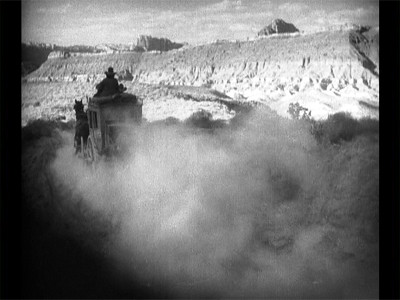
Unfortunately, this isn't as big of a deal as it sounds. The microphones barely picked up anything beyond a few feet, so for a ten second shot of a man riding a horse, you might hear the hoof beats for about two seconds, followed by eight seconds of total silence. More minor sounds that would create atmosphere, like the wind, weren't picked up.
The locations in Arizona were certianly photogenic, but with such weak sound sources, it would have been a lot more satisfying to just give the non-dialogue portions of the film to a foley artist. Not that there's a lot of those. This is a "talkie," and it earns that title. This film will NOT SHUT UP! It's wall-to-wall boring conversations between three bad actors, and it's enough to drive you bonkers.
Let's start with Baxter.
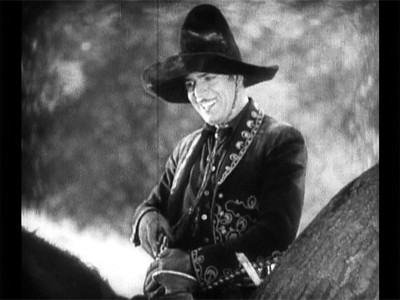
Warner Baxter, who won the Academy Award for acting somehow, plays the Cisco Kid, #1 outlaw of the west, and oversized hat connoisseur! This is my first film with Warner Baxter, and I'm not sure what his acting strengths are (or if he even has any). He's never allowed to physically act throughout the entire film, he just stands there with a smile and reads off his lines.
And he keeps talking, and talking, AND TALKING. He never stops talking. There are a lot of scenes where he's alone, and he just talks to himself. He sees a wanted poster for him, and he laughs and gives a monologue about how awesome he is. He monologues about everything: about how awesome his girl is, about how awesome babies are (seriously), about how awesome his wine is, etc.
And despite all this talking-and-nothing-else, Warner Baxter isn't very good at it. Maybe it's his faux-Mexican accent (even though the character is Portuguese, figure that one out). Maybe Baxter couldn't play young (the character was 25 and Baxter was 39). Maybe he just couldn't get over how goofy and large his hat was.
In any case, Baxter was bad, and the Cisco Kid was uninteresting. The description of the film I read compared the Cisco Kid to a wild west version of Robin Hood, which is nothing but a complete misunderstanding on what Robin Hood was about. Robin Hood didn't just "steal from the rich and gave to the poor," he fought a corrupt government that squeezed money unfairly from it's citizens. The Cisco Kid just stole stuff.

The opening of the film shows the Cisco Kid stealing a box of money from a carriage, and then leaving. The people the Kid steals from aren't rich or corrupt or anything, they were just passing through, and the Kid never has any intention though the film to do anything with the money but buy things for him and his girl. What an asshole.
It should be noted that in this classic western story of law makers and law breakers, there's hardly any action in it. The carriage stickup is just the Cisco Kid pointing a gun at a few people, them giving him the money, and him leaving. No shots fired, no hasty escapes, just routine.

There's only one scene in the movie that would qualify as an action scene. About two-thirds of the way through, three random guys spot the Cisco Kid and try to take him down for the reward on his head, but the Cisco Kid makes quick work of them. It's a quick moment, shot from a distance, and has nothing to do with what little plot there is in the film. So, with those two short moments out of the way, what left for the remaining 60+ minutes of film?
Talking, talking, talking, talking, TALKING.
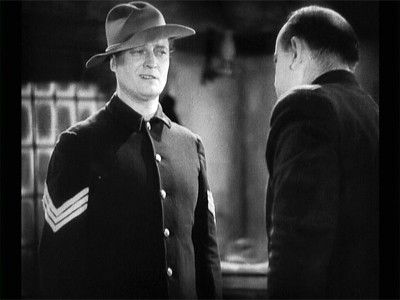
And then we have Edmund Lowe and his character Sgt. Dunn. Despite being the Cisco Kid's main foil, Dunn comes off even worse of a character. He's a gambler and a womanizer who cheats on his wife, and he's only really after the Kid for the money, not because it's the right thing to do. The main problem with this is that Edmund Lowe must not have gotten the memo and thought he was playing the good guy, because despite what this character does, Lowe always plays the character as an aw-shucks-boy scout that ends every sentence with "geez".
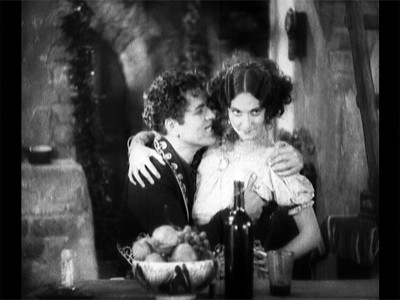
And then we have Dorothy Burgess and her character, the feisty Mexican Tonia Maria. Tonia is a gold digger, and sleeps with other men behind the Kid's back. She's easily the least-likable character in the film, and it doesn't help that Burgess' performance is damn near racist.
Eventually, Tonia gets with Dunn, and we realize that the only reason we're even rooting for the Cisco Kid, a selfish bandit, is because everybody else is WORSE. What we end up with is an hour and a half film where three totally unlikeable characters do nothing but talk to each other about nothing, all while being played by three bad actors. This is what Hollywood wanted to pretend was entertainment back then.
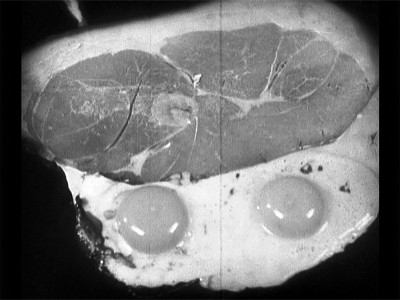
DIRECTED BY: Irving Cummings
STARRING: Warner Baxter, Edmund Lowe, Dorothy Burgess
WON: Best Actor (Warner Baxter)
NOMINATED FOR: Best Cinematography (Arthur Edeson)
Best Director (Irving Cummings)
Best Writing, Achievement (Tom Barry)
Best Picture
There was a reason the early sound films were called "talkies." Most shoots were limited to a single microphone, and that was usually reserved for the dialogue. It was hard to pick up sounds that weren't within a few feet of it, so films were enclosed on sets to allow for easier sound pick-up.
This is what gives In Old Arizona it's claim to fame: Along with being the first sound western, it's the first sound film that largely takes place outdoors.

Unfortunately, this isn't as big of a deal as it sounds. The microphones barely picked up anything beyond a few feet, so for a ten second shot of a man riding a horse, you might hear the hoof beats for about two seconds, followed by eight seconds of total silence. More minor sounds that would create atmosphere, like the wind, weren't picked up.
The locations in Arizona were certianly photogenic, but with such weak sound sources, it would have been a lot more satisfying to just give the non-dialogue portions of the film to a foley artist. Not that there's a lot of those. This is a "talkie," and it earns that title. This film will NOT SHUT UP! It's wall-to-wall boring conversations between three bad actors, and it's enough to drive you bonkers.
Let's start with Baxter.

Warner Baxter, who won the Academy Award for acting somehow, plays the Cisco Kid, #1 outlaw of the west, and oversized hat connoisseur! This is my first film with Warner Baxter, and I'm not sure what his acting strengths are (or if he even has any). He's never allowed to physically act throughout the entire film, he just stands there with a smile and reads off his lines.
And he keeps talking, and talking, AND TALKING. He never stops talking. There are a lot of scenes where he's alone, and he just talks to himself. He sees a wanted poster for him, and he laughs and gives a monologue about how awesome he is. He monologues about everything: about how awesome his girl is, about how awesome babies are (seriously), about how awesome his wine is, etc.
And despite all this talking-and-nothing-else, Warner Baxter isn't very good at it. Maybe it's his faux-Mexican accent (even though the character is Portuguese, figure that one out). Maybe Baxter couldn't play young (the character was 25 and Baxter was 39). Maybe he just couldn't get over how goofy and large his hat was.
In any case, Baxter was bad, and the Cisco Kid was uninteresting. The description of the film I read compared the Cisco Kid to a wild west version of Robin Hood, which is nothing but a complete misunderstanding on what Robin Hood was about. Robin Hood didn't just "steal from the rich and gave to the poor," he fought a corrupt government that squeezed money unfairly from it's citizens. The Cisco Kid just stole stuff.

The opening of the film shows the Cisco Kid stealing a box of money from a carriage, and then leaving. The people the Kid steals from aren't rich or corrupt or anything, they were just passing through, and the Kid never has any intention though the film to do anything with the money but buy things for him and his girl. What an asshole.
It should be noted that in this classic western story of law makers and law breakers, there's hardly any action in it. The carriage stickup is just the Cisco Kid pointing a gun at a few people, them giving him the money, and him leaving. No shots fired, no hasty escapes, just routine.

There's only one scene in the movie that would qualify as an action scene. About two-thirds of the way through, three random guys spot the Cisco Kid and try to take him down for the reward on his head, but the Cisco Kid makes quick work of them. It's a quick moment, shot from a distance, and has nothing to do with what little plot there is in the film. So, with those two short moments out of the way, what left for the remaining 60+ minutes of film?
Talking, talking, talking, talking, TALKING.

And then we have Edmund Lowe and his character Sgt. Dunn. Despite being the Cisco Kid's main foil, Dunn comes off even worse of a character. He's a gambler and a womanizer who cheats on his wife, and he's only really after the Kid for the money, not because it's the right thing to do. The main problem with this is that Edmund Lowe must not have gotten the memo and thought he was playing the good guy, because despite what this character does, Lowe always plays the character as an aw-shucks-boy scout that ends every sentence with "geez".

And then we have Dorothy Burgess and her character, the feisty Mexican Tonia Maria. Tonia is a gold digger, and sleeps with other men behind the Kid's back. She's easily the least-likable character in the film, and it doesn't help that Burgess' performance is damn near racist.
Eventually, Tonia gets with Dunn, and we realize that the only reason we're even rooting for the Cisco Kid, a selfish bandit, is because everybody else is WORSE. What we end up with is an hour and a half film where three totally unlikeable characters do nothing but talk to each other about nothing, all while being played by three bad actors. This is what Hollywood wanted to pretend was entertainment back then.

Sunday, May 17, 2009
Roland West and Alibi
Finally! An interesting movie!
Alibi (1929)
DIRECTED BY: Roland West
STARRING: Chester Morris, Harry Stubbs, Mae Busch
NOMINATED FOR: Best Actor in a Leading Role (Chester Morris)
Best Art Direction (William Cameron Menzies)
Best Picture
It's kind of heartwarming to discover that SOMEBODY was trying to use sound artistically this early in it's history. Most sound films at the time were just stationary cameras filming people talking. Sound was just that, sound. A gunshot was a gunshot, a footstep was a footstep, and a scream was a scream. There was very few attempts to bring symbolization into sound this early in the game.
Alibi is a dated, creaky film now, but put into context, and it's pretty amazing. The very opening scene is a montage of simple sounds. A prison guard twirls his baton, creating a beat.

A bell is rung to the same beat.
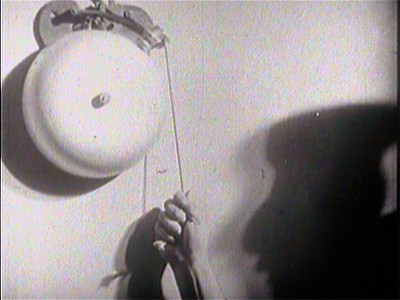
Prisoners drag their feet.

Another prison guard beats his baton against a wall.
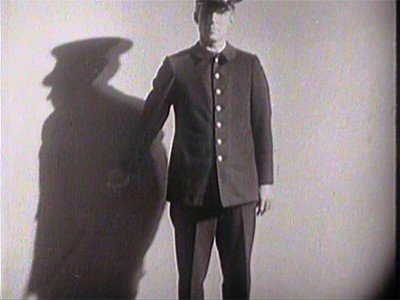
This is the earliest musical moment I've seen in sound pictures. The film is not a musical, but the simple beat and the poetic images suggest the opening moments of a modern music video. Most musicals at that time were simply Broadway performances put in front of a camera, usually involving dancing girls with glittery costumes.
Alibi has those too, though.
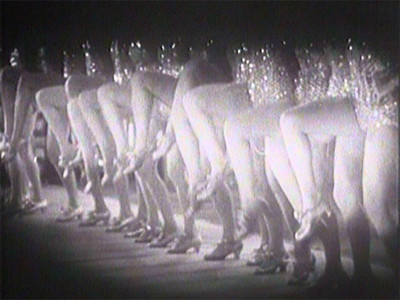
This is the main problem with Alibi, it has split personalities. The film was originally conceived as a silent film, but the success of talkies forced director Roland West to transform it into a sound film.
What we end up with is a film where half the scenes are like the one at the beginning, filmed silent with sound dubbed in later, and the other half falling into the same claptrap of all the other early sound films, with glittery flow-stopping musical numbers and people standing in rooms talking while the camera doesn't move.

The plot is at least interesting, so we have that to get us through the exposition scenes. The film revolves around the relationship between ex-con Chick Williams and the police. For the first half of the film, we learn that the police planted a gun on Chick which resulted in him going to prison. When Chick gets out, he connects with the daughter of the police sergeant that framed him, much to the father's dismay.
If the film has anything to say, it's that, sure, criminals are bad, but the police are not much better. Chick's framing is the big off-screen example of the police's questionable tactics, but that's not enough for us. We have to see these guys do their dirty laundry themselves.

During a heist, a police officer is shot, and the police are going to get answers no matter what. They bring in a two-bit thug and start questioning him, demanding a name out of him even though he claims an alibi.
This scene is my favorite in the entire film. Roland West did a lot of experimenting with sound in the film, and he may have been one of the first directors to discover that with sound comes silence. Silent films never had the luxury of silence, with live music always being played. With a sound film, when the sound goes away, you pay attention, you get tense. So, when a mysterious face appears in a door...

...and one officer goes to stand by the window...

...and the other officer wipes the fingerprints off a gun...
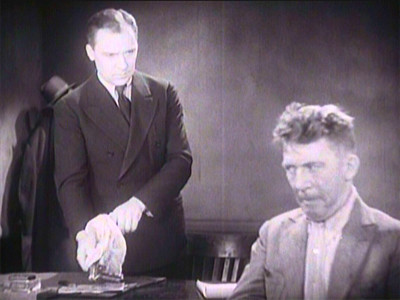
...and there's no sound to explain it all, no sound to comfort you, then your heart really starts to race.
It's amazing how hopeful I get when I see someone trying to regain the artistic freedom lost by technology. As CGI continues to take over films, I hope we get more and more directors who try and implement it in new and artistic ways.
Again, the film is still a mixed bag, and that goes for it's other elements. It was nominated for it's art direction by our old friend William Cameron Menzies. Some descriptions of the film has dubbed it "inspired by German expressionism," but I don't agree. However, the slightly off-beat art deco is something to enjoy.

So while Menzies' production design is a hit, the acting is a big, big miss. It seems most of the actors involved were still suffering from the jitters of converting to silent style to talkie style. Chester Morris, nominated for Best Actor for his role as Chick Williams, always seems like he's trying to squeeze his skull out of his head.

However, the worst offender is Regis Toomey, playing an undercover detective named Danny McGann. His cover? Drunken Wall Street broker.
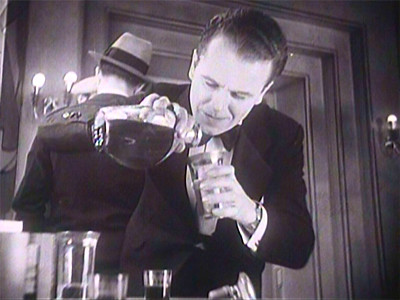
Danny's drunk character is so over the top it's laughable. At first I thought the character of Danny was a bad actor, but when Danny's cover is blown and we see the real character, I realized that it was Regis that was the bad actor. Every scene with Danny is sooooo drawn out and annoying, and it makes sense that his most drawn out and annoying scene is when he dies.

It takes minutes for him to finally go. He tells everyone his regrets, makes his finally wishes, etc., all with twenty second pauses between each line. And finally, right before he dies, UKULELE MUSIC STARTS PLAYING! What is this crap!?!
*sigh* Such is the nature of this film. If you want the good, you got to take the bad. It's certainly the best film from the 2nd Academy Awards I've looked at so far, and in this sea of dead weights, you take what you can get.

Alibi (1929)
DIRECTED BY: Roland West
STARRING: Chester Morris, Harry Stubbs, Mae Busch
NOMINATED FOR: Best Actor in a Leading Role (Chester Morris)
Best Art Direction (William Cameron Menzies)
Best Picture
It's kind of heartwarming to discover that SOMEBODY was trying to use sound artistically this early in it's history. Most sound films at the time were just stationary cameras filming people talking. Sound was just that, sound. A gunshot was a gunshot, a footstep was a footstep, and a scream was a scream. There was very few attempts to bring symbolization into sound this early in the game.
Alibi is a dated, creaky film now, but put into context, and it's pretty amazing. The very opening scene is a montage of simple sounds. A prison guard twirls his baton, creating a beat.

A bell is rung to the same beat.

Prisoners drag their feet.

Another prison guard beats his baton against a wall.

This is the earliest musical moment I've seen in sound pictures. The film is not a musical, but the simple beat and the poetic images suggest the opening moments of a modern music video. Most musicals at that time were simply Broadway performances put in front of a camera, usually involving dancing girls with glittery costumes.
Alibi has those too, though.

This is the main problem with Alibi, it has split personalities. The film was originally conceived as a silent film, but the success of talkies forced director Roland West to transform it into a sound film.
What we end up with is a film where half the scenes are like the one at the beginning, filmed silent with sound dubbed in later, and the other half falling into the same claptrap of all the other early sound films, with glittery flow-stopping musical numbers and people standing in rooms talking while the camera doesn't move.

The plot is at least interesting, so we have that to get us through the exposition scenes. The film revolves around the relationship between ex-con Chick Williams and the police. For the first half of the film, we learn that the police planted a gun on Chick which resulted in him going to prison. When Chick gets out, he connects with the daughter of the police sergeant that framed him, much to the father's dismay.
If the film has anything to say, it's that, sure, criminals are bad, but the police are not much better. Chick's framing is the big off-screen example of the police's questionable tactics, but that's not enough for us. We have to see these guys do their dirty laundry themselves.

During a heist, a police officer is shot, and the police are going to get answers no matter what. They bring in a two-bit thug and start questioning him, demanding a name out of him even though he claims an alibi.
This scene is my favorite in the entire film. Roland West did a lot of experimenting with sound in the film, and he may have been one of the first directors to discover that with sound comes silence. Silent films never had the luxury of silence, with live music always being played. With a sound film, when the sound goes away, you pay attention, you get tense. So, when a mysterious face appears in a door...

...and one officer goes to stand by the window...

...and the other officer wipes the fingerprints off a gun...

...and there's no sound to explain it all, no sound to comfort you, then your heart really starts to race.
It's amazing how hopeful I get when I see someone trying to regain the artistic freedom lost by technology. As CGI continues to take over films, I hope we get more and more directors who try and implement it in new and artistic ways.
Again, the film is still a mixed bag, and that goes for it's other elements. It was nominated for it's art direction by our old friend William Cameron Menzies. Some descriptions of the film has dubbed it "inspired by German expressionism," but I don't agree. However, the slightly off-beat art deco is something to enjoy.

So while Menzies' production design is a hit, the acting is a big, big miss. It seems most of the actors involved were still suffering from the jitters of converting to silent style to talkie style. Chester Morris, nominated for Best Actor for his role as Chick Williams, always seems like he's trying to squeeze his skull out of his head.

However, the worst offender is Regis Toomey, playing an undercover detective named Danny McGann. His cover? Drunken Wall Street broker.

Danny's drunk character is so over the top it's laughable. At first I thought the character of Danny was a bad actor, but when Danny's cover is blown and we see the real character, I realized that it was Regis that was the bad actor. Every scene with Danny is sooooo drawn out and annoying, and it makes sense that his most drawn out and annoying scene is when he dies.

It takes minutes for him to finally go. He tells everyone his regrets, makes his finally wishes, etc., all with twenty second pauses between each line. And finally, right before he dies, UKULELE MUSIC STARTS PLAYING! What is this crap!?!
*sigh* Such is the nature of this film. If you want the good, you got to take the bad. It's certainly the best film from the 2nd Academy Awards I've looked at so far, and in this sea of dead weights, you take what you can get.

Tuesday, May 12, 2009
Mary Pickford and Coquette
Coquette (1929)
DIRECTED BY: Sam Taylor
STARRING: Mary Pickford, Johnny Mack Brown, Matt Moore
WON: Best Actress in a Leading Role (Mary Pickford)
I have to admit, I really miss the 1st Academy Awards. There was the questionable win and nomination here and there, but for the most part the films were interesting and deserved the accolades they received.
However, it took merely a year for the Academy to fall into controversy. That year, the award for Best Actress was expected to go to Ruth Chatterton for her role in Madame X (a film I sadly haven't been able to find). Instead, it went to Mary Pickford for Coquette. Why the controversy? Two reasons:
1) Mary Pickford was arguable the most powerful woman in Hollywood at the time. She began starring in movies in the 1910s, starring in 52 of them overall. Her youthful appearance and trademark curly hair made her on of the biggest stars of the silent era. Some say there was a point where she was more famous then Chaplin. Appearances in public were known to cause riots. One of her curls sold for $15,000 in auction. She was a superstar.
And she used that superstar status to change the film industry from the inside. She became her own producer after three years of starring in films. Pickford's films were distributed through their own distribution unit. In 1919, she founded her own studio, United Artists, along with Chaplin, director D.W. Griffith and soon-to-be husband Douglas Fairbanks Sr. The company became a much-needed home for independent film producers at the time.
And most importantly, she was one of the founders of the Academy of Motion Picture Arts and Sciences, the group behind the Academy Awards. She was the only female member at the time, and even if Pickford HAD given the best performance that year, people would still have cried favoritism.
2) Mary Pickford did not give the best performance that year. Coquette is an awful, awful film.
This film is the first all-talkie picture reviewed on this site. While The Jazz Singer had a synced soundtrack, actual dialogue was reduced to a few songs and one brief monologue. This film is wall-to-wall conversations, and since microphones weren't mobile at the time, that meant everyone had to stay in the same area with little movement.
See this chair?
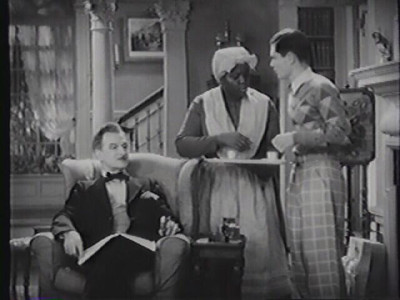
The microphone is somewhere around that chair, so most of the movie is people awkwardly standing around the chair chatting. That chair gets more screen time then any of the actors.
The film takes place in some Southern state, where a rich doctor deals with her teenage daughter Norma (Pickford was in her 30s at the time) and the suitors that come to her door. Yes, for the third time in the 2nd Academy Awards, we're dealing with a Rich Person Melodrama. Anyway, Norma shows interest in a poor man from the mountains, and her father won't hear of it, and tries to hook Norma up with his dull rich friend. EXCITING!
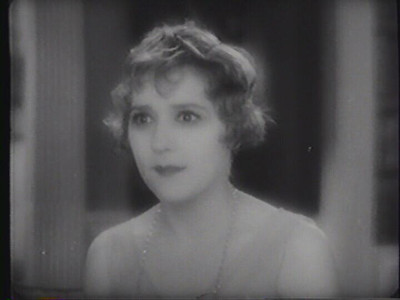
Again, Mary Pickford was almost twice the age of the character she was playing, and I guess she got it into her head that she had to exaggerate the youthful aspect of the character, and she really comes off annoying and fake. Remember, acting for silent films or for stage were different, and one had to be more subtle for sound films.
You know, here. Here's a seven-minute clip from the film to give you an idea of what I'm talking about:
"Ooh. Aren't they just.... adorable?"
The entire film is this. People standing in rooms, giving comically bad line readings and corny gestures. Mary Pickford is the queen of corny gestures.
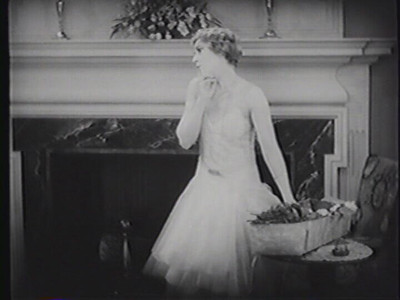
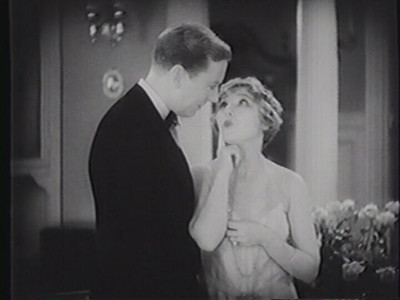
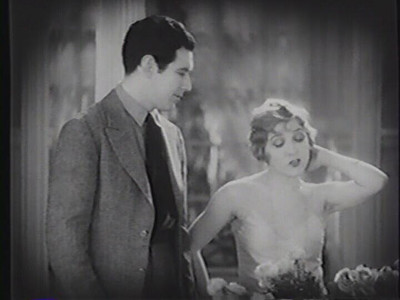
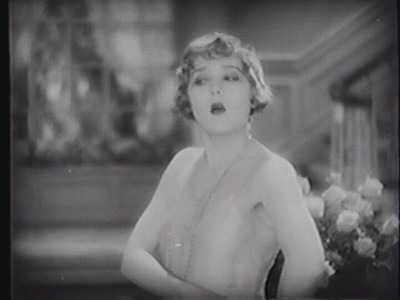
Coquette might as well be the flagship of the horrible films made at the beginning of the sound era. I should point out that I think Mary Pickford was a good silent actress, so it's not like she was untalented, but it's clear that sound was her undoing. The film was a critical failure and didn't make money, and Pickford quickly lost the fame she spent twenty years gaining. She only made two more films after this before retiring to the role of producer only.
But even with the troubles she had, I don't feel too forgiving. Her win in this category was pure politics. With sound destroying the industry and the Academy already patting itself on the back, it's clear just how dark of a time for movies it was.
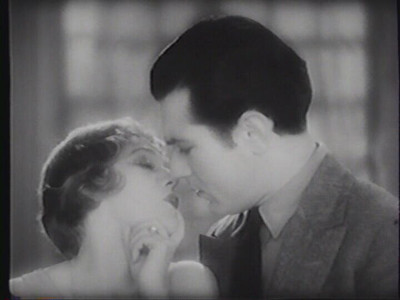
DIRECTED BY: Sam Taylor
STARRING: Mary Pickford, Johnny Mack Brown, Matt Moore
WON: Best Actress in a Leading Role (Mary Pickford)
I have to admit, I really miss the 1st Academy Awards. There was the questionable win and nomination here and there, but for the most part the films were interesting and deserved the accolades they received.
However, it took merely a year for the Academy to fall into controversy. That year, the award for Best Actress was expected to go to Ruth Chatterton for her role in Madame X (a film I sadly haven't been able to find). Instead, it went to Mary Pickford for Coquette. Why the controversy? Two reasons:
1) Mary Pickford was arguable the most powerful woman in Hollywood at the time. She began starring in movies in the 1910s, starring in 52 of them overall. Her youthful appearance and trademark curly hair made her on of the biggest stars of the silent era. Some say there was a point where she was more famous then Chaplin. Appearances in public were known to cause riots. One of her curls sold for $15,000 in auction. She was a superstar.
And she used that superstar status to change the film industry from the inside. She became her own producer after three years of starring in films. Pickford's films were distributed through their own distribution unit. In 1919, she founded her own studio, United Artists, along with Chaplin, director D.W. Griffith and soon-to-be husband Douglas Fairbanks Sr. The company became a much-needed home for independent film producers at the time.
And most importantly, she was one of the founders of the Academy of Motion Picture Arts and Sciences, the group behind the Academy Awards. She was the only female member at the time, and even if Pickford HAD given the best performance that year, people would still have cried favoritism.
2) Mary Pickford did not give the best performance that year. Coquette is an awful, awful film.
This film is the first all-talkie picture reviewed on this site. While The Jazz Singer had a synced soundtrack, actual dialogue was reduced to a few songs and one brief monologue. This film is wall-to-wall conversations, and since microphones weren't mobile at the time, that meant everyone had to stay in the same area with little movement.
See this chair?

The microphone is somewhere around that chair, so most of the movie is people awkwardly standing around the chair chatting. That chair gets more screen time then any of the actors.
The film takes place in some Southern state, where a rich doctor deals with her teenage daughter Norma (Pickford was in her 30s at the time) and the suitors that come to her door. Yes, for the third time in the 2nd Academy Awards, we're dealing with a Rich Person Melodrama. Anyway, Norma shows interest in a poor man from the mountains, and her father won't hear of it, and tries to hook Norma up with his dull rich friend. EXCITING!

Again, Mary Pickford was almost twice the age of the character she was playing, and I guess she got it into her head that she had to exaggerate the youthful aspect of the character, and she really comes off annoying and fake. Remember, acting for silent films or for stage were different, and one had to be more subtle for sound films.
You know, here. Here's a seven-minute clip from the film to give you an idea of what I'm talking about:
"Ooh. Aren't they just.... adorable?"
The entire film is this. People standing in rooms, giving comically bad line readings and corny gestures. Mary Pickford is the queen of corny gestures.




Coquette might as well be the flagship of the horrible films made at the beginning of the sound era. I should point out that I think Mary Pickford was a good silent actress, so it's not like she was untalented, but it's clear that sound was her undoing. The film was a critical failure and didn't make money, and Pickford quickly lost the fame she spent twenty years gaining. She only made two more films after this before retiring to the role of producer only.
But even with the troubles she had, I don't feel too forgiving. Her win in this category was pure politics. With sound destroying the industry and the Academy already patting itself on the back, it's clear just how dark of a time for movies it was.

Labels:
2nd Academy Awards,
Best Actress,
Mary Pickford
Tuesday, May 5, 2009
Legs and Our Dancing Daughters
Our Dancing Daughters (1928)
DIRECTED BY: Harry Beaumont
STARRING: Joan Crawford, Anita Page, Dorothy Sebastian
NOMINATED FOR: Best Cinematography (George Barnes)
Best Writing, Achievement (Josephine Lovett)
I find I have a bad habit of pretending I know something about culture and the history of culture. For some years I ran a pop culture website where I feign expertise on what people used to do and why they do it. However, I've come to realize I can't even grasp my own culture, which is completely different to the culture of ten years ago, which is different to the etc etc etc.
But if there's one thing I've learned, it's that in the 20s, it was all about the legs!
Our Dancing Daughters is a boring love story made in the heyday of the Jazz Age (the stupid white people jazz, not the awesome New Orleans jazz). It's not funny or exciting or emotional, it's just sleep inducing, and I see no real reason to return to it. However, it did bring to light something that I never realized. In the 20s, when a lustful man gazed at a woman, it was usually directed at her legs.
I'm not saying legs aren't still sexualized, but in these old films, they're the ONLY thing that's sexualized. As far as Hollywood was concerned, even pre-code Hollywood, breasts and other womanly curves just didn't exist. I have no idea why, really. I can assume it has something to do with the religious influence that was leading into the 50s, but I'm simply not qualified to say for certain. All I know is that Our Dancing Daughters is about sexuality, and sexuality is all about legs.
Our three main female character are all introduced BY their legs. First, Diana, a woman who takes a party girl persona in public, but inside is really romantic and wants to settle down:
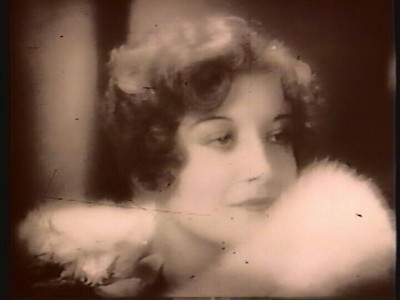
She's introduced in the movie as a pair of dancing legs in front of the mirror, getting ready for the big party.
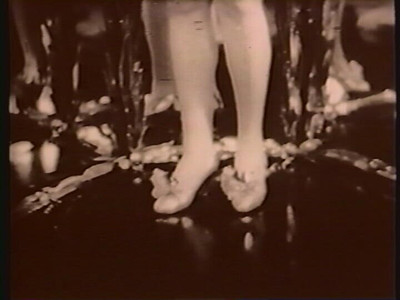
And then we have Beatrice, a woman who insists on not fooling around and really can't be bothered to party.
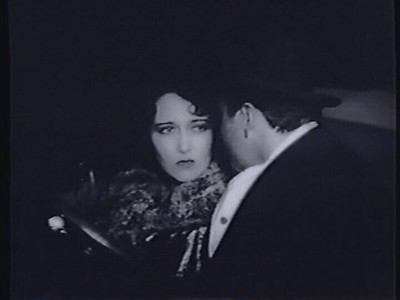
We meet here from behind, standing still as her overprotective parents give her a stern talking to.
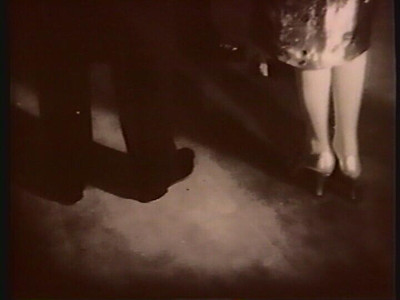
And finally, we have Ann, a gold digger, a woman who's only interested in marrying a rich man for his money.
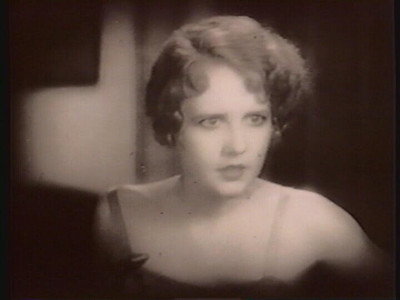
She only has interest in nice things, so when we meet her legs, we find her tearing and discarding some worn-out stockings.
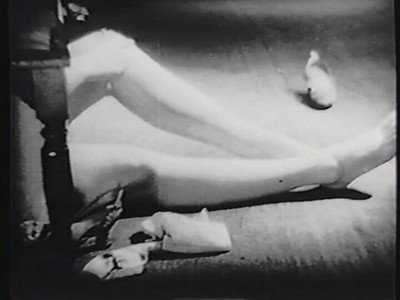
Our female characters are characterized by their legs, which proves that shallow characterization has been present as long as film's been around. It's like when female characters in modern day action movies are characterized by hair color and cup size. To pound this point home, Ben, the man for our characters to swoon over, is introduced LOOKING at legs.
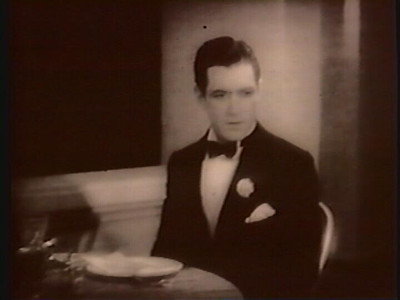
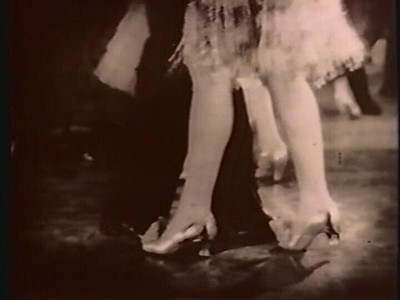
When people think back to the golden days of cinema, it's hard to imagine that there were shallow sexual films. What was "shallow" and "sexual" back in the 20s are alien to us now, and it makes trying to understand these times seem kinda futile.
If you're really interested in Our Dancing Daughters, you can find it on Youtube HERE.
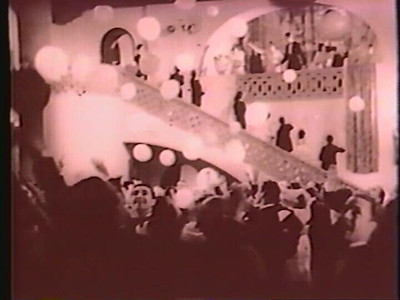
DIRECTED BY: Harry Beaumont
STARRING: Joan Crawford, Anita Page, Dorothy Sebastian
NOMINATED FOR: Best Cinematography (George Barnes)
Best Writing, Achievement (Josephine Lovett)
I find I have a bad habit of pretending I know something about culture and the history of culture. For some years I ran a pop culture website where I feign expertise on what people used to do and why they do it. However, I've come to realize I can't even grasp my own culture, which is completely different to the culture of ten years ago, which is different to the etc etc etc.
But if there's one thing I've learned, it's that in the 20s, it was all about the legs!
Our Dancing Daughters is a boring love story made in the heyday of the Jazz Age (the stupid white people jazz, not the awesome New Orleans jazz). It's not funny or exciting or emotional, it's just sleep inducing, and I see no real reason to return to it. However, it did bring to light something that I never realized. In the 20s, when a lustful man gazed at a woman, it was usually directed at her legs.
I'm not saying legs aren't still sexualized, but in these old films, they're the ONLY thing that's sexualized. As far as Hollywood was concerned, even pre-code Hollywood, breasts and other womanly curves just didn't exist. I have no idea why, really. I can assume it has something to do with the religious influence that was leading into the 50s, but I'm simply not qualified to say for certain. All I know is that Our Dancing Daughters is about sexuality, and sexuality is all about legs.
Our three main female character are all introduced BY their legs. First, Diana, a woman who takes a party girl persona in public, but inside is really romantic and wants to settle down:

She's introduced in the movie as a pair of dancing legs in front of the mirror, getting ready for the big party.

And then we have Beatrice, a woman who insists on not fooling around and really can't be bothered to party.

We meet here from behind, standing still as her overprotective parents give her a stern talking to.

And finally, we have Ann, a gold digger, a woman who's only interested in marrying a rich man for his money.

She only has interest in nice things, so when we meet her legs, we find her tearing and discarding some worn-out stockings.

Our female characters are characterized by their legs, which proves that shallow characterization has been present as long as film's been around. It's like when female characters in modern day action movies are characterized by hair color and cup size. To pound this point home, Ben, the man for our characters to swoon over, is introduced LOOKING at legs.


When people think back to the golden days of cinema, it's hard to imagine that there were shallow sexual films. What was "shallow" and "sexual" back in the 20s are alien to us now, and it makes trying to understand these times seem kinda futile.
If you're really interested in Our Dancing Daughters, you can find it on Youtube HERE.

Wednesday, April 22, 2009
Bess Meredyth Vs. William H. Daniels: A Woman of Affairs
A Woman of Affairs (1928)
DIRECTED BY: Clarence Brown
STARRING: Greta Garbo, John Gilbert, Lewis Stone
NOMINATED FOR: Best Writing, Achievement (Bess Meredyth)
"In the old silent days, [William H.] Daniels had been the best of them all. His camera work was so close to art that producers and directors and cameramen used to sit in private projection rooms, not to judge a picture, but to see what new tricks of lighting and effects Daniels had achieved. The industry acknowledged that Daniels' work was so fine that other cameramen were never censured for shamelessly stealing it".
-Mark Hellinger, producer
Every year, when the Academy Awards role around, there's always something to complain about. How in the world did such-and-such get nominated? Why was this nominated over that? Why was this aspect of the film nominated but not this aspect? These strange choices, the result of both ballot voting and inner-politics, have been consistent with the Academy since the beginning, and A Woman of Affairs is an early example of it.
The film was nominated for it's writing, but it's story is muddled, it's dialogue is over-dramatic, and it's pace is uneven.
The film was NOT nominated for it's cinematography, even though it has some great dramatic lighting, it uses it's space well, and its tracking shots are mind blowing for a film this old.
Cinematographer William H. Daniels was been nominated four times for his work, winning once. He made over 150 films from the 20s to the 60s. Bess Meredyth wrote some Zorro movies. Ok, maybe I'm being disingenuous, one's success does not directly reflect one's quality and character, but seeing a film praised for it's weakest quality and having it's strongest quality ignored just seems so typical of the Academy these days.
This is the film's opening shot:
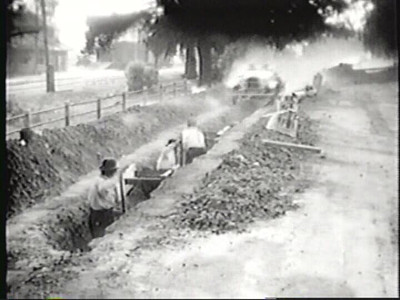
Our main character, Diana Merrick, goes all CRAZY WOMAN DRIVER and haphazardly drives her car into puddles, avoiding other drivers by a fraction of an inch, and finally nearly decapitating half a dozen road workers.
It's a typical screwball comedy gag, and it's high energy suggests we're in for a wild and zany ride! Problem is, this scene is in no way related with the rest of the movie. Nowhere else in the film do we get off-the-wall physical comedy or any general goofiness. It's not even consistent with the character. We see Diana drive several times after this scene, and she does so safely and calmly.
It's almost as if they started writing one film and suddenly changed their minds. This isn't the first time we'll have this type of shift of tone, but it is the most jarring.
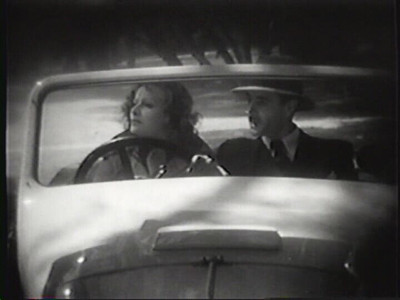
So, now that those meaningless gags are out of the way, it's storytime. Diana is a young British aristocrat in love with slightly-less aristocratic Neville Holderness. Through flashback, we see that they've known each since childhood, and Diana, still an overgrown child, clings to the "strong male sweeps her away" fantasy of her youth, and Neville thinks she's cute, so hey, win-win.
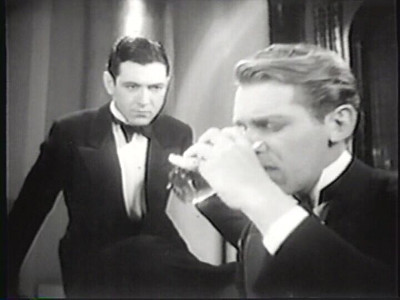
Meanwhile, Diana's brother Jeffry (right) drinks away his sorrows (though what those sorrows are, we never find out) while his best friend David Furness (left) tries to talk him out of the booze.
Neither of these two are well-written characters. Jeffry does two things throughout the film: mope around and act angry for no defined reason, and show a damn-near homosexual amount of admiration to David. David's role in the film is simply to react to Jeffry. Both these characters are empty shells that simply offer plot devices when the story needs them to.
So, after some short meaningless scenes of Jeffry and Diana fighting and then making up, we cut to the next day, where we're introduced to two more characters. First, Dr. Hugh Trevelyan:
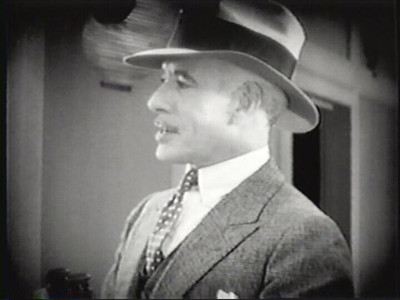
An old friend of Diana and Jeffry. HE'S NICE!
And then there's Sir Morton Holderness:
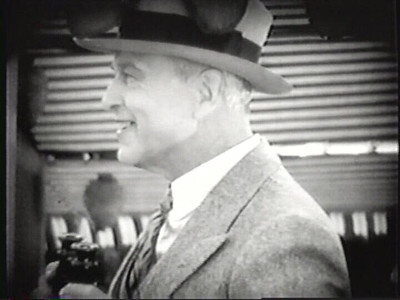
Neville's father. HE'S NOT SO NICE!
In case you couldn't tell already, the biggest flaw in this film is that the characters are totally depthless with one possible exception, but we won't meet her till much later in the film. All these characters do is allow the plot to move forward, and we never spend anytime learning their reasons for doing these things.
So, Diana and Neville talk for a bit, and we learn that Diana is richer then Neville, and Neville, with his outdated masculinity, can't stand the idea of her supporting him. He suggests the idea of him leaving for a few years to start business in Egypt, but is only deterred when Diana threatens to leave him.
I really need to point out there is no dramatic difference between Diana's and Neville's fortunes. I mean, look at Neville's house!
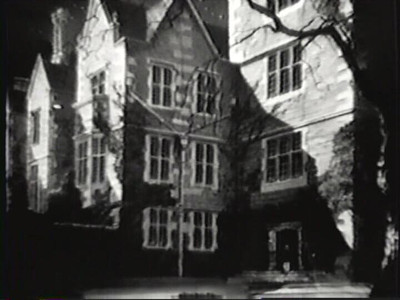
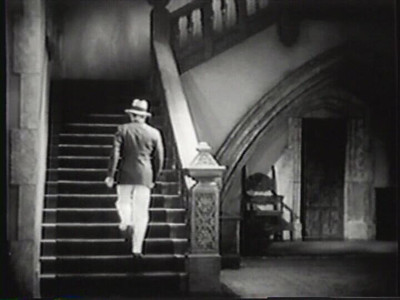
TWO PEOPLE LIVE IN THIS HOUSE! This isn't some fish-out-of-water love relationship, this is a story about a guy who feels less like a man because he has ten million dollars and she has eleven million. This film is "the rich and restless," and who wants to watch that? Sorry guys, I'd love to hear about your petty struggles, but I gotta go work at WAL-MART!
Anyway, Neville does end up going to Egypt after a long off-screen talk with his father, who acts as the makeshift villain in this film. Diana learns of this, and as an act of petty revenge, marries Jeffry's friend David instead.
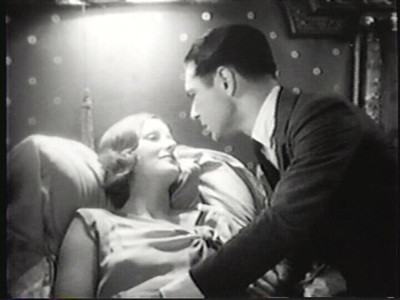
Of course, Diana doesn't love David, but David is too blissful to be aware of these. In any case, David has other things to worry about, because on their honeymoon, there's a mysterious knock at the door.
Up to this point, the cinematography is pretty standard, but this moment, which also acts as a tonal shift in the film, is when it really starts to shine. David, with an expression of total terror on his face, slowly approaches the door, and we follow him with a long, tension-building tracking shot through two rooms.
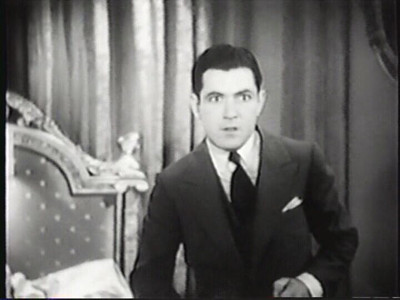

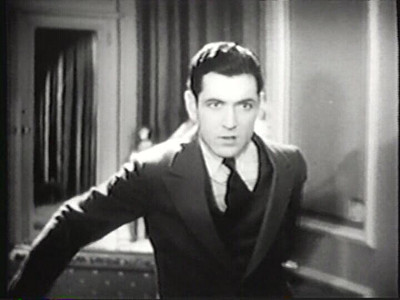
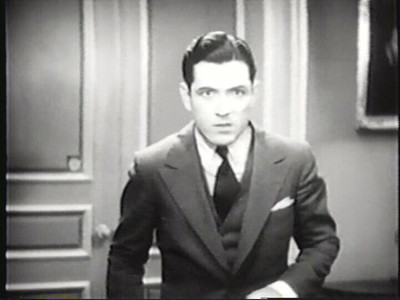
This is the first of nearly a dozen tracking shots in the film, and they're all done really, really well, and brings forth the main theme in the cinematography: these people live in empty space, which could reflect the emptiness in each of the characters if I believed the film was trying to be that deep.
Later, the film seems to switch to more natural lighting and frames the characters from far away, allowing the characters to get lost in dark voids. Take these shots from later in the film for example:
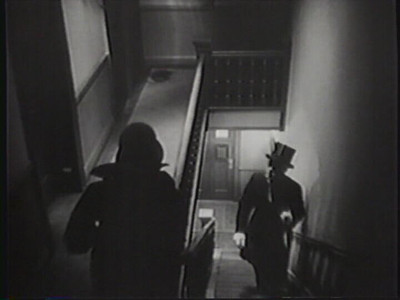
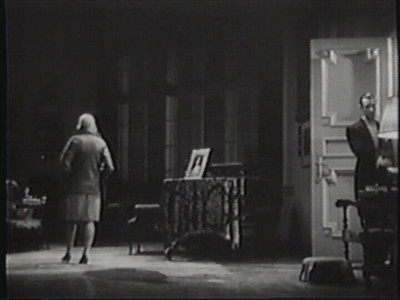
One scene much later in the film takes place in a hospital, which is brightly lit, but the empty space is still overwhelming.

This emptiness is made even more pronounced by how far apart the characters are from each other.
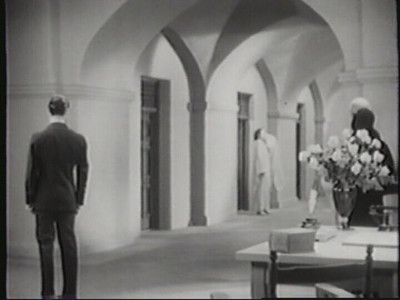
There's a lot of shots I could analysis for you, but these are the basic tricks used throughout the second half of the film, and they really give the film a much-needed flavor boost. There really isn't much more to add to that: The story is pointless and shallow and the cinematography makes me giddy. End review.
But wait, who was knocking on the door? Will Diana and Neville get back together? I'll leave that for you to find out, because you can watch A Woman of Affairs on Youtube HERE.
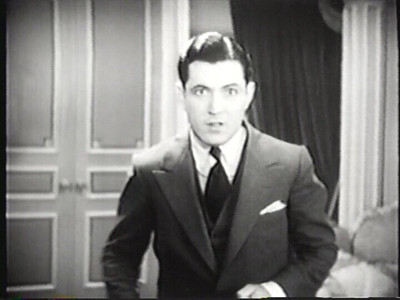
DIRECTED BY: Clarence Brown
STARRING: Greta Garbo, John Gilbert, Lewis Stone
NOMINATED FOR: Best Writing, Achievement (Bess Meredyth)
"In the old silent days, [William H.] Daniels had been the best of them all. His camera work was so close to art that producers and directors and cameramen used to sit in private projection rooms, not to judge a picture, but to see what new tricks of lighting and effects Daniels had achieved. The industry acknowledged that Daniels' work was so fine that other cameramen were never censured for shamelessly stealing it".
-Mark Hellinger, producer
Every year, when the Academy Awards role around, there's always something to complain about. How in the world did such-and-such get nominated? Why was this nominated over that? Why was this aspect of the film nominated but not this aspect? These strange choices, the result of both ballot voting and inner-politics, have been consistent with the Academy since the beginning, and A Woman of Affairs is an early example of it.
The film was nominated for it's writing, but it's story is muddled, it's dialogue is over-dramatic, and it's pace is uneven.
The film was NOT nominated for it's cinematography, even though it has some great dramatic lighting, it uses it's space well, and its tracking shots are mind blowing for a film this old.
Cinematographer William H. Daniels was been nominated four times for his work, winning once. He made over 150 films from the 20s to the 60s. Bess Meredyth wrote some Zorro movies. Ok, maybe I'm being disingenuous, one's success does not directly reflect one's quality and character, but seeing a film praised for it's weakest quality and having it's strongest quality ignored just seems so typical of the Academy these days.
This is the film's opening shot:

Our main character, Diana Merrick, goes all CRAZY WOMAN DRIVER and haphazardly drives her car into puddles, avoiding other drivers by a fraction of an inch, and finally nearly decapitating half a dozen road workers.
It's a typical screwball comedy gag, and it's high energy suggests we're in for a wild and zany ride! Problem is, this scene is in no way related with the rest of the movie. Nowhere else in the film do we get off-the-wall physical comedy or any general goofiness. It's not even consistent with the character. We see Diana drive several times after this scene, and she does so safely and calmly.
It's almost as if they started writing one film and suddenly changed their minds. This isn't the first time we'll have this type of shift of tone, but it is the most jarring.

So, now that those meaningless gags are out of the way, it's storytime. Diana is a young British aristocrat in love with slightly-less aristocratic Neville Holderness. Through flashback, we see that they've known each since childhood, and Diana, still an overgrown child, clings to the "strong male sweeps her away" fantasy of her youth, and Neville thinks she's cute, so hey, win-win.

Meanwhile, Diana's brother Jeffry (right) drinks away his sorrows (though what those sorrows are, we never find out) while his best friend David Furness (left) tries to talk him out of the booze.
Neither of these two are well-written characters. Jeffry does two things throughout the film: mope around and act angry for no defined reason, and show a damn-near homosexual amount of admiration to David. David's role in the film is simply to react to Jeffry. Both these characters are empty shells that simply offer plot devices when the story needs them to.
So, after some short meaningless scenes of Jeffry and Diana fighting and then making up, we cut to the next day, where we're introduced to two more characters. First, Dr. Hugh Trevelyan:

An old friend of Diana and Jeffry. HE'S NICE!
And then there's Sir Morton Holderness:

Neville's father. HE'S NOT SO NICE!
In case you couldn't tell already, the biggest flaw in this film is that the characters are totally depthless with one possible exception, but we won't meet her till much later in the film. All these characters do is allow the plot to move forward, and we never spend anytime learning their reasons for doing these things.
So, Diana and Neville talk for a bit, and we learn that Diana is richer then Neville, and Neville, with his outdated masculinity, can't stand the idea of her supporting him. He suggests the idea of him leaving for a few years to start business in Egypt, but is only deterred when Diana threatens to leave him.
I really need to point out there is no dramatic difference between Diana's and Neville's fortunes. I mean, look at Neville's house!


TWO PEOPLE LIVE IN THIS HOUSE! This isn't some fish-out-of-water love relationship, this is a story about a guy who feels less like a man because he has ten million dollars and she has eleven million. This film is "the rich and restless," and who wants to watch that? Sorry guys, I'd love to hear about your petty struggles, but I gotta go work at WAL-MART!
Anyway, Neville does end up going to Egypt after a long off-screen talk with his father, who acts as the makeshift villain in this film. Diana learns of this, and as an act of petty revenge, marries Jeffry's friend David instead.

Of course, Diana doesn't love David, but David is too blissful to be aware of these. In any case, David has other things to worry about, because on their honeymoon, there's a mysterious knock at the door.
Up to this point, the cinematography is pretty standard, but this moment, which also acts as a tonal shift in the film, is when it really starts to shine. David, with an expression of total terror on his face, slowly approaches the door, and we follow him with a long, tension-building tracking shot through two rooms.




This is the first of nearly a dozen tracking shots in the film, and they're all done really, really well, and brings forth the main theme in the cinematography: these people live in empty space, which could reflect the emptiness in each of the characters if I believed the film was trying to be that deep.
Later, the film seems to switch to more natural lighting and frames the characters from far away, allowing the characters to get lost in dark voids. Take these shots from later in the film for example:


One scene much later in the film takes place in a hospital, which is brightly lit, but the empty space is still overwhelming.

This emptiness is made even more pronounced by how far apart the characters are from each other.

There's a lot of shots I could analysis for you, but these are the basic tricks used throughout the second half of the film, and they really give the film a much-needed flavor boost. There really isn't much more to add to that: The story is pointless and shallow and the cinematography makes me giddy. End review.
But wait, who was knocking on the door? Will Diana and Neville get back together? I'll leave that for you to find out, because you can watch A Woman of Affairs on Youtube HERE.

Subscribe to:
Posts (Atom)